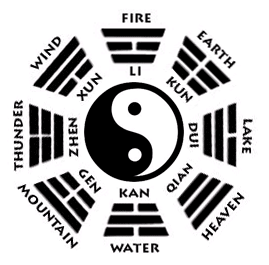The Yi Jing (I Ching in the old Wade-Giles) is the famous oracle system of ancient China. Originally, the Chinese diviners used turtle shells and bones to answer questions of kings, nobles and common people ‘yes’ or ‘no’ depending on how they would crack over a fire. Turtles were thought to be symbolic of the cosmos, as their shells resembled heaven, round on the top, and earth, flat on the bottom. Unfortunately, being sacred did not help the Chinese turtle, as their numbers depleted from all the divination to the point that turtles were imported from Vietnam and other southern lands and cattle bones began to be used as substitutes. The Yi Jing replaced this earlier system about 1000 BCE with the rise of the Zhou dynasty. Many systems of thought were influenced by the Yi Jing in the Warring States period, including Confucianism and Daoism. Confucians and Daoists wrote commentaries on the books. Confucius considered the Yi Jing to be one of the six great classics of the tradition of the sage emperors, and made it central to his educational system that became the entrance exams for getting a position in the Imperial bureaucracy.
The original system is attributed to Fu Xi, a mythical king who is said to have discovered the symbols of the Yi Jing hexagrams in the stars. It was then said to have been re-systematized by King Wen, one of the founders of the Zhou dynasty. It is impossible today to know whether these kings were the sages behind the system, or if the system was finalized as a book by Confucius himself around 500 BCE.
The system is built out of eight trigrams which in pairs of upper and lower trigram form sixty four hexagrams. Each trigram is build out of solid and/or broken lines, solid signifying yang and broken signifying yin. In ancient times, a question was asked and sticks were tossed to determine each line, starting from the top down. The counter-culture of the fifties, sixties, seventies and eighties, including surfers (who were introduced to Daoism in Hawaii), beatniks, hippies, and new age spiritual seekers, would toss coins, often quarters, heads being yang, and tails being yin. Six tosses equals six lines, giving two trigrams, one heaven and one earth. The trigrams are:
☰ Heaven (Creative)
☱ Lake (Reflecting/Excess)
☲ Fire (Bright/Conscious/Clinging)
☳ Thunder (Exciting)
☴ Wind/Wood (Penetrating/Growth)
☵ Water (Dark/Danger/Profound)
☶ Mountain (Steady/Still)
☷ Earth (Receptive)
Notice that Creation is the beginning of the end Reception (heaven and earth), Bright is the beginning of the end Darkness (fire and water), Excitement or agitation is the beginning of the end Growth (thunder and wind), Stillness is the beginning of the end Excess (mountain and lake). When we invert a hexagram, changing its solid lines to broken and broken lines to solid, the opposite has an opposite role in process and change.
There are eight hexagrams that are composed of a trigram and its reverse or mirror image: Creation (heaven on heaven), Insight (wind on lake), Synergy (fire on fire), Nourishing (Mountain on Thunder), Critical Mass (lake on wind), Danger (water on water), Mindfulness (thunder on mountain) and Reception (earth on earth). Four of these eight hexagrams are composed of the same trigram twice, the trigrams that are symmetrical. The inversions are interesting as Insight is the beginning of the end Mindfulness, and Nourishing is the beginning of the end Critical Mass. This is very similar to the inversions amongst the trigrams.
There are 8 hexagrams that are composed of a trigram and its inverse, the diagonal from bottom left to top right of the Fu Xi order: Prosper (earth on heaven), Decline (mountain on lake), After Ends (water on fire), Benefit (wind on thunder), Continuing (thunder on wind), Before Ends (fire on water), Attraction (lake on mountain), and Stagnation (heaven on earth). Prosper/Stagnation and After Ends/Before Ends are both inverses and reverses, and also that Prosperity and Stagnation are positive and negative beginnings, and After Ends and Before Ends are positive and negative endings. Prosperity is a beginning that is beginning, Stagnation is a beginning that is not beginning, After Ends is an end that has ended, Before Ends is an end that has not ended. We have a beginning that is and isn’t and an end that has been or isn’t yet.
When we compare the original Fu Xi order with the later King Wen order, it becomes clear that the Fu Xi order is composed of inversions and alternates while the King Wen order is based in reversals. The Fu Xi order is composed of sets of inversions and alternates. The King Wen order is not composed of inversions or alternates but is essentially a list of hexagrams and their reversals from start to finish. This is why Creation and Reception are hexagram one and hexagram two for King Wen but they are the first and last hexagram of the Fu Xi. King Wen took the hexagrams and focused on matching each with its reversal without regard for the essential inversions and alternates of Fu Xi.
The Early Modern German philosopher Leibniz invented the binary system still used by computers today, which may or may not give way to something else like quantum computers in the near future. Leibniz was a sinophile, and invented his binary system, which represents all numbers in terms of ones and zeros, inspired by the Yi Jing divination system. Leibniz was communicating with Christian missionaries in China, and he, like some of the missionaries, believed that Europeans could learn much from Confucianism that was in line with Christianity. Also an admirer of the Chinese abacus, Leibniz was one of the most important innovators of the mechanical calculator, an early computer which employed his binary system. Thus, our computers, internet and phones are in part based on the ancient Chinese Yi Jing.









